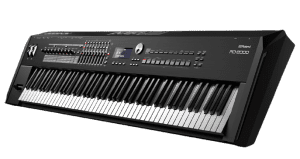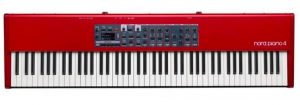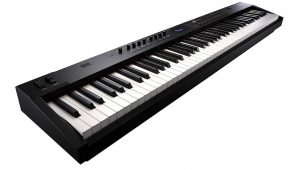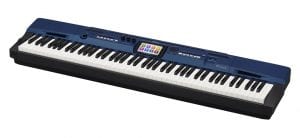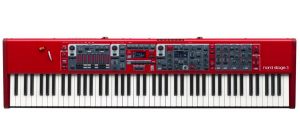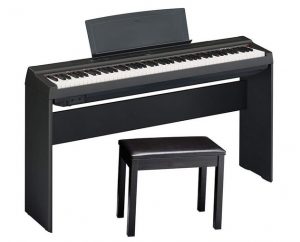The world of stage pianos could be extremely confusing and overwhelming even for the seasoned pianist. When it comes to digital pianos, the two major aspects that we should check are the sound and the feel of the digital piano. Both these tasks are quite difficult as they get too much into this musical instrument. The strings, the hammers, and the keys of the digital piano are the elements that create its sound and it has to be bought with great caution. Here are some of the best stage pianos from some of the amazing brands and the ways to choose the best stage pianos.
Quick Summary
Also check: Top 5 Best Upright Pianos for Advanced Pianists
Top 6 Best Stage Pianos 2024
#1. Roland RD-2000 Premium Stage Piano – Best Overall
This is one of the best digital stage pianos that come with a power cord, damper padel, and owner’s manual for stage shows. We have to find the piano stand separately for stage shows. The weight of this piano is about 47 lbs. The piano features a graphic LCD of 256 x 80 dots. This weighted keyboard features an 88-note hammer action and its power supply will adjust automatically with different line voltages.
Its supernatural sound engine features two independent sound engines and features modern controller features. It has eight knobs with LED status indicators and nine sliders for real-time control of sounds and their effects. The piano features a dedicated acoustic piano sound with the latest Roland advancements, that provides an authentic, and richly detailed tone with complete polyphony. The PHA-50 keyboard features hybrid wood and a molded construction for premium touch and long-lasting durability.
For real-time control of sounds and effects in this piano, there are eight knobs with LED status indicators and nine sliders. There are eight fully assignable zones for combining external sources and internal sounds. The RD 2000 is capable of rendering unmatched performance both on stage and in the studio.
Pros
- The piano features eight fully assignable zones for combining both internal sounds and external sources.
- Its second supernatural-based sound engine features a 128-voice polyphony for additional sounds and electric pianos.
- The piano offers the best recreation of vintage analog effects, including the BOSS CE-1 Chorus.
- The piano is designed for the stage, with its intuitive and navigating interface.
Cons
- It comes only with a single pedal for Sostenuto.
- The piano doesn’t have a Bluetooth feature.
Note: Roland RD-2000 is also featured in our lists of the top 15 best pianos in the market and best-advanced pianos.
#2. Nord Piano 4 Stage Piano – Editor’s Choice
This is a fourth-generation award-winning piano series from Nord, and it features an expanded voice polyphony, a premium triple sensor key bed, and an acclaimed virtual hammer action technology for the ultimate piano experience. The Nord Piano 4 also includes tremendous and brilliant new performance features such as seamless transitions, dedicated piano filters, and a split point crossfade, that deliver a life-focused keyboard performance with an exceptional piano feel. The Nord Piano 4 piano has dedicated knobs and buttons for all the essential functions that are required in a live performance situation.
The piano features two sound sections that can be combined in a layer or split over the keyboard. Each of the sound sections of this piano has specific effects, and also features a volume pedal and sustain pedal that is assigned to them. The instrument has seven split points and is indicated with LED lights.
The piano also has a crossfade functionality, that offers a smooth transition between two split zones. The enhanced organize mode includes the copy-paste and the move functionality for rearranging the programs quickly in the desired order.
All the programs, pianos, and synth samples can be navigated easily that rendering numerical, alphabetical, and category sorting options. It is also an optional new numeric pad mode that offers the players instant access to programs by entering the program number. Its enhanced piano section features a broad selection of the latest electric, acoustic, and digital pianos from the exclusive Nord Piano Library, thus expanding voice polyphony and creating new piano filters.
Pros
- The sample synth section of the piano features expanded memory for the Nord sample library with expanded voice polyphony.
- The effect section features a great selection of instantly tweakable high-quality stereo effects.
- It is possible to assign the effects freely to the piano or the sample synth section.
Cons
- There are no obvious side effects in this digital piano.
Note: Nord Piano 4 is also featured in our lists of the best digital pianos under $3000 and $5000.
#3. Roland RD-88 Professional Stage Piano – Great Sound Quality
The Roland digital pianos have been a choice of professional pianists for more than 30 years around the world. The acclaimed RD sound engine of the piano makes it a lighter, easier to access, and more affordable instrument.
For more than three decades, the Roland Digital pianos have been trusted by professionals, on stages all over the world. In this stage of piano, we get sturdy controls and reliable and smooth keyboard action, that feels natural. The piano is never stiff or spongy.
The piano features a lightweight and compact design and it’s thus easy to transport and set up. The ivory feel piano touch keyboard helps with world-class playability and there are three zones in this piano with an external control and Apple MainStage integration. The pianist can convert their piano goals into a reality with three months of free piano lessons. It also offers the ultimate online piano lesson experience. The pianist will also get ultimate access to everything inside the Pianote.
Pros
- This is an excellent supernatural piano that features an easy-to-use interface, that is optimized for performance.
- The Ivory feel piano-touch keyboard helps with world-class playability.
- The piano features a room-filling onboard keyboard system with a lightweight and compact design.
Cons
- We have to buy a separate piano stand for this stage piano.
- It has an inbuilt speaker, but its volume is very low.
#4. Casio PX560BE – Amazing Stage Piano Under $2000
This is an excellent digital piano that comes in an impressive blue color. The PX-560 features Casio’s renowned Tri-sensor scaled hammer action II keyboard, with accurately reproduces the touch and response of the concert grand piano. The keys of the piano are heavier in the lower register and are lighter on the top, similar to the real concert grand pianos. The keys of the piano are textured with ebony and ivory keys, that not only feel real but also render the hands a positive grip on the keys, to keep playing the instrument.
Its multi-dimensional air sound source delivers some of the best pianos sounds that you have ever heard. The Piano goes beyond the definition of the traditional definition of the stage piano and it includes 550 tones, covering a huge variety of musical instruments and genres. Its 5.3” clear display, makes the display easy to read and the entire interface of the piano is very much simple and is also exceptionally inspiring.
The first look of the piano portrays it in a striking blue case and it also boasts the most impressive sonic technology. It is an easy-to-use instrument that sounds great as it looks. For advanced piano players, the PX-560 delivers a comprehensive set of features that will enhance the music to great heights. With this piano in hand, it will find the players examining themselves with new ideas, thus creating great music.
Pros
- This piano features an exceptional sound design for sound designers.
- The piano is designed to perform and makes the piano sound at its best.
- The instrument features a built-in studio and offers the best tools for taking up piano lessons.
- The piano has a class-compliant USB port that connects with Mac, OC, and iOS devices.
Cons
- Before playing a piano tone, the modulation wheel should be rolled toward the front of the keyboard, to make sure that the tone will not have any unnatural vibrato applied to it.
Note: Casio PX560BE is also featured in our list of the best digital pianos under $2000.
#5. Nord Stage 3 Digital Piano – Complete Package
The Nord Stage 3 digital piano has an exceptional acoustic sound-generating sound engine and includes three sections. It includes a Piano, organ, and synthesizer, all of which can be used simultaneously. The Nord Stage 3 digital piano has two separate slots, allowing the pianist to have two pianos, two organs, and two synths, along with other effects at the same time for massive sonic flexibility.
The Nord Stage 3 digital piano also features three split zones and a new split point crossfade functionality. It chooses between three different crossfade widths, that are indicated by different LED colors. There is also a new split point editor mode that allows you to easily organize and set up the split points, by making use of the OLED display, rendering you a great overview of the assigned sound sources for each of the split zones.
The Nord Stage 3 digital piano supports program change through a pedal, allowing for flexible program changes while keeping the hands on the keyboard.
The effect section of the Nord Stage 3 piano features a brand new filter effect, extending to many morphable parameters, an exceptional delay effect, and a separate reverb and compressor for each of the slots.
Its powerful effect sections feature a range of instantly tweakable high-quality effects that are modeled after classic stompboxes, available for each of the slots.
Pros
- The Nord Stage 3 88-key digital piano features a complete weighted hammer action key bed.
- It features a lightweight hammer action portable key bed with a semi-weighted waterfall key bed with physical drawbars.
- You can easily lock the effect rate to a range of note values, to gently sweep the filters up and down in half notes.
Cons
- The piano doesn’t have built-in speakers.
- We need an amplifier to hear the keyboard sounds external.
Check out: Best Sounding Digital Pianos: Top 10 Most Realistic Pianos
#6. Yamaha P125 Digital Piano – Budget Pick
This is an exceptional digital piano for stage performances, and it comes with a complete bundle with a furniture bench and a furniture stand. The piano comes with a fully weighted digital piano with 88 full-sized piano-style keys. The GHS-weighted action of the piano is heavier at the lower keys and lighter at the higher keys, similar to an acoustic piano. The pure CF sound engine of the piano faithfully reproduces the tone of the acclaimed Yamaha 9’ CFIIIS Concert Grand Piano.
The piano offers the best USB-to-host connectivity with MIDI and audio transfers, thus we require only one cable to connect with the music-making software.
The piano is designed to store easily and it features pedals, headphones, and the main power adapter with sturdy double-braced stands to fold easily. The P-125 is a large instrument that weighs nearly 12 kg. You would require assistance to move the piano carefully and offer support.
This is a compact and portable digital piano that combines exceptional piano performance with a user-friendly and minimalistic design. The piano is portable and extremely easy to use and offers the joy of playing the piano on one’s terms. The piano is capable of rendering high-quality sounds with natural touch response, by maintaining a sleek and slim footprint. Every single element of the P 125 stage piano has been designed to enhance the focus of the players on the stage.
Pros
- The piano features a unique sound engine, which is a result of years of piano craftsmanship.
- The P-125 reproduces the sounds of the Yamaha CFIIIS 9’ concert grand piano faithfully.
- Its graded 88-key standard action keyboard is heavier at the lower ends and lighter at the higher ends, similar to the acoustic pianos.
Cons
- It is better to upgrade to a better quality foot pedal, as the piano comes with an entry-level foot pedal.
Note: Yamaha P125 is also featured in our lists of the best home digital pianos and digital pianos for composing.
Things to Consider Before Choosing the Best Stage Pianos
A lot goes into the decision of buying a digital stage piano, that has to be carried around during gigs and for stage shows. It is important to consider some of the following important aspects, before buying a digital piano. The goal of this post is to help you make an informed decision while shopping for a digital piano for stage shows, that meets one’s budget and needs.
1. Sound quality of the stage piano
The sound quality of the digital piano is an obvious factor, that the pianist has to pay close attention to. Beginner pianists will not require high-end tones and sounds and thus they can go with a piano that is moderately priced. If your budget allows, you can go for a high-end piano with the best sound quality. Pianos with the best tune quality will help pianist improve their skills. Speakers are also important aspects to consider in the digital piano, as they are responsible for the primary sound output from the instrument. The output of the pianos will also depend on how best the pianist plays them.
2. Piano Polyphony
Polyphony is the number of tones and notes that the digital piano is capable of producing instantly. It is also the number of tones that the pianist can play at one time, without getting cut off early. Some of the best digital pianos start with the standard 32-note polyphony. the high-end stage pianos however have as many as 200 polyphony notes. The higher the polyphony, the better will be the chances of producing complex piano sounds. Make sure that the digital piano that you choose possesses enough polyphony, irrespective of your expertise in playing the instrument.
3. Unique features of the piano
if you want to get the best out of your stage piano, then you should make sure that it has all the features in-built into the instrument. These features will help you in picking out the best digital piano and helps you offer a great stage show every time. Some of the key features to consider while choosing a stage piano are, the metronome, split mode, dual-mode, recording and playback feature, transpose and tuning function, etc. The more features of the piano, the better will be the playing style and quality of the piano music.
4. Portability of the piano
Portability is an important factor to consider when choosing to buy a digital stage piano. Gigging musicians who are planning different venues with the digital piano should choose a lightweight and compact instrument that is easy to carry around. If you need a digital piano for home use, then you should go with a heavy-weight piano model, but make sure it adapts to the space availability in the home.
5. Speakers of the piano
Though the internal speakers of the piano will not be loud enough for stage shows and even for the smallest of gigs. Though we require external amplification, it is still important to choose pianos that have sturdy XLR audio outputs at the back panel. The internal speakers of the piano should be great enough to fit a small room full of music.
6. MIDI connectivity
MIDI connectivity is an integral part of the stage pianos and if you are someone who wishes to crate and compose music, then you should consider a stage piano with ample MIDI connectivity. This will also help you to connect the digital piano with the digital audio workstation of choice, to be able to record yourself playing. With the stage piano you choose, you should also be able to make use of thousands of readily available plugins in the piano.
7. Piano Accessories
Stage pianos come with a lot of add-ons and make sure that you buy a digital piano that comes with sustain pedals so that you don’t have to spend your money having to buy a separate sustain pedal. Some of the cabinet-style digital pianos come with their built-in piano stands and some pianos also come with three pedalboards similar to an acoustic piano.
Musicians who are playing at live concerts will prefer having to switch between the different sounds as quickly as possible on the stage. Make sure the piano has easy-to-access shortcuts to accomplish this feature. Also, make sure that the digital piano you are buying is compatible with the companion apps to download new tunes to play along with the flow of piano music on the stage shows.
Ways To Assess The Sound Quality Of A Piano.
When assessing a piano’s overall performance, its sound quality is an important consideration. A piano’s sound quality is influenced by several elements, including the materials used in its construction, its design, and the expertise of the piano technician who maintains it. In this post, we will look at a few different ways to evaluate a piano’s sound quality. There are many ways to evaluate a piano’s sound quality. Playing the piano is one of the best methods to judge its sound quality. Tone, pitch, and resonance are important considerations when playing the piano.
In all ranges, a top-notch piano should generate a warm, even tone without any harsh or boring notes. No notes should sound out of tune, and the piano’s pitch should stay constant. The notes on the piano should resonate evenly and continue to vibrate after they are played, producing a full-bodied sound. Another important consideration when assessing the piano’s sound quality is the piano’s touch. A top-notch piano should have a responsive touch that enables the player to achieve a variety of expressiveness and dynamic levels. The piano ought should respond quickly to the player’s touch, enabling a variety of dynamics and articulations.
Fast and accurate playing is possible if the keys are simple to push and rapidly return to their resting positions. The piano’s tuning stability and maintenance record must also be considered when evaluating the sound quality of the instrument. No matter how well-built or designed a piano is, it will not sound good if it’s out of tune or badly maintained. A piano needs to be tuned and maintained regularly to maintain a constant, high-quality sound over time.
In conclusion, examining the piano’s tone, pitch, resonance, dynamic range, touch, materials, and construction, as well as its tuning stability and maintenance history, is necessary to determine the sound quality of a piano. One can find a high-quality piano that will generate a rich, lively sound for years to come by paying attention to these aspects.
All About Polyphony
The term “polyphony” describes a musical texture in which several distinct melodies are played at once. Each voice is treated as a distinct melody with its own rhythm, harmony, and contour in polyphonic music. Since the Middle Ages, polyphonic music has been a part of Western music, mostly in the context of sacred music. The majority of religious music in the Middle Ages was Gregorian chants, which were frequently sung in a monophonic texture, which means that only one tune was played at a time. Nonetheless, as the music progressed, composers started experimenting with playing numerous tunes at once.
Throughout the Classical era, homophonic textures—in which a single melody is backed by accompanying harmonies—started to overtake polyphony as the dominant musical form. Nonetheless, polyphony continued to be a significant aspect of music, especially in Mozart and Beethoven’s compositions. Western music’s use of polyphony was still significant in the 20th century. In their works, composers like Stravinsky, Bartok, and Schoenberg frequently combined other approaches like serialism and atonality with polyphonic textures. Music and cultural relevance of polyphony are significant. It enables the development of intricate, layered textures that can represent a variety of moods and feelings. The expressive power of music is increased by polyphony, which also permits the investigation of various harmonic and rhythmic possibilities.
Polyphony also has cultural relevance because it has long been a crucial component of Western music and has helped to shape many musical genres and styles. In conclusion, polyphony has played a significant role in Western music for many years. Since its inception in the organum, polyphony has been used by composers to produce complex and sophisticated musical textures. Because it has been a crucial component of Western music for centuries, its relevance extends beyond just its musical possibilities. It also has cultural significance.
How to choose the speakers for the piano?
The correct speakers for a piano should be chosen based on the piano’s size, type, intended use, and personal tastes, among other things. Here are some general principles to consider so that you can decide wisely:
- The size and kind of piano should be taken into consideration. Speakers with a wider frequency response and more power are needed for larger pianos, such as grand pianos, than for smaller pianos, like uprights. The sound creation can also vary depending on the type of piano, with some providing a brighter sound than others.
- Choose the intended purpose of the speakers: If you want to use them for live performances, you will need speakers that are strong, transportable, and powerful enough to fill the venue. You might want speakers that offer a more realistic sound representation if you intend to use them for recording or practicing.
- Establish a budget. Before choosing speakers, it’s important to decide how much you can afford to pay because speaker prices might range widely.
- Try out, several speakers. The easiest method to figure out which speakers are ideal for your piano is to try out various speakers. To hear how various speakers sound with your piano, visit a music store or check out online demos.
- Think about these extra features. Some speakers also include extra features like EQ settings, Bluetooth connectivity, and built-in amplifiers. Think about if any of these qualities would be beneficial for your needs.
The ideal speakers for your piano will ultimately depend on your unique requirements and tastes. To ensure that you make an informed selection, it is crucial to take the time to research and evaluate several options.
What are the necessary piano accessories?
There are a variety of piano accessories that can improve your performance and keep your instrument in good condition. Here are some essential piano extras you might require:
- For good posture and playing technique, a piano bench or stool that is comfortable and adjustable is necessary.
- To hold your sheet music or tablet device while playing, you’ll need a reliable music stand.
- A metronome is a gadget that aids in maintaining a constant tempo while training.
- A piano lamp is a practical item that offers sufficient lighting for studying music notation in poorly lit spaces.
- A piano cover can shield your instrument from debris, dampness, and other elements that could harm the piano.
- Caster cups for pianos are helpful if your piano has wheels. They shield your flooring from dings and keep the piano from sliding.
- Piano cleaning supplies: Keeping the piano in good condition requires routine cleaning. To keep your piano clean, use a soft cloth, a piano cleaning solution, and a keyboard cover.
- A piano humidifier keeps the instrument from drying out or breaking by controlling the humidity levels inside the instrument.
These are some necessary piano accessories that can improve your playing and help you take care of your instrument. You could need extra accessories like pedal extenders, headphones, or recording gear according to your individual requirements and tastes.
What are the ways the piano can be connected to other devices?
The piano is a flexible instrument that may be coupled with other techniques to improve the playing experience, create, and record music, and increase its functionality. The following are some connections that the piano can make to other gadgets:
- Musical Instrument Digital Interface, or MIDI, is an acronym. It is a protocol that enables interaction between electronic instruments, such as the piano, and other gadgets like computers and synthesizers. With software like a DAW, you may utilize a MIDI-enabled piano to record and generate music, create digital sheet music, and control virtual instruments.
- With an audio interface, you can record your piano’s sound in top-notch quality using a device that connects to your computer. A 1/4″ instrument cable or a microphone can be used to connect your piano to an audio interface. The analog audio signal from the piano will be transformed into a digital signal via the audio interface so that it can be recorded on your computer.
- Amplifiers: Amplifiers are tools that boost your piano’s sound volume. A 1/4″ instrument cable can be used to link your piano to an amplifier. Also, some amplifiers include built-in effects like reverb and chorus that can improve the sound of your piano.
- Wireless Speakers: You can play music wirelessly from a Bluetooth-enabled piano by connecting it to wireless speakers. You may start playing right away by simply utilizing Bluetooth to pair your piano with the speakers.
- Headphones: You can attach headphones to your piano’s headphone jack if you wish to play the piano in peace. As you can hear your music without any outside noise, this is very helpful for practicing and recording.
- Pedals: You may attach additional pedals like sustain, soft, and sostenuto pedals to some digital pianos via their pedal inputs. You may play more expressive music and the piano’s capabilities are increased as a result.
In conclusion, the piano can be connected to a variety of gadgets, such as pedals, computers, audio interfaces, amplifiers, wireless speakers, and headphones. These connections can expand the piano’s capabilities, improve the playing experience, and record and generate music. It’s crucial to pick the appropriate connections for your unique requirements and preferences and to always abide by the manufacturer’s setup and usage instructions.
Conclusion
The stage pianos are built for live performance and not for home practice and most of them have dark slabs with a screen and a lot of buttons. There are several factors and features to consider before picking up a digital piano for live stage shows. Choose the piano that complements your playing style and helps in achieving your music goals on the stage. We hope our product recommendations and our buying guide help in picking up one of the best stage pianos.
An 88-key digital piano with exceptional sound quality and performance in a small and portable design is the Kawai ES110. A sleek gloss black finish for the piano is an option, adding a touch of class to any room. For pianists of all experience levels, from beginners to experts, the ES110 is the best option. The responsive keyboard action of the Kawai ES110 is one of its most noteworthy features. Kawai’s Advanced Hammer Action IV-F, which replicates the feel and touch of an acoustic piano, is a feature of the piano. Similar to an acoustic piano, the action is weighted and graded, making the lower keys heavier and the higher keys lighter.
The mobility of the Kawai ES110 is another noteworthy quality. The piano may be readily taken to performances, rehearses, or lessons because it only weighs 26 pounds. Enough volume is provided by the robust built-in speakers for small to medium-sized spaces. The ES110 also features several connectivity options, including MIDI, USB, and Bluetooth. In order to record and create music, the piano may be connected to computers or other devices via its MIDI and USB ports, and its Bluetooth connectivity enables wireless audio streaming from mobile devices.
In conclusion, the Kawai ES110 digital piano is a premium instrument that features quick keyboard action, superior sound quality, and mobility. It is appropriate for a number of playing techniques and musical genres because of its extensive selection of instrument sounds, connectivity choices, and dual and split modes. The piano is a well-liked instrument among pianists of all skill levels, and the sophisticated gloss black finish elevates any environment.
Frequently Asked Questions (FAQs)
1. What Are the Sounds That the Stage Pianos Come With?
Make sure that the piano that you buy, sounds authentic like a concert grand piano. Make sure the piano you choose to buy features some good organ emulations, synth bass, and lead sounds. If you are working in theatres and for stage shows, you will require everything from grand pianos to string sections and special effects.
2. What Are the Size and the Type of Keyboard That You Require?
The stage pianos come in two or three different sizes, namely the 88-key model, the 76-key model, and even some compact models with fewer keys. Stage pianists should choose 88-key piano models with hammer action and weighted keyboards, to give them an acoustic grand feel. The smaller size pianos are aimed at synth players and organists.
3. What Should Be the Weight and Build Quality of the Piano?
Stage pianos are designed to make rocking and pounding performances one after another. Make sure the stage piano you choose has tougher casings and features a lot of robust buttons and switches. The encoder stalks and the slider poles should be made of metal and not plastic. The check ends of the piano are commonly made of wood and plastic. Make sure the piano you choose is light and easy to carry from gig to gig.
4. A Sustain Pedal Is What?
A sustain pedal is a foot-operated instrument that a pianist can use to extend or sustain the piano notes’ sound. The dampers inside the piano are lifted when the pedal is depressed, allowing the strings to freely vibrate and create a prolonged sound.
5. Can I Play My Piano With Headphones On?
Yes, most digital pianos contain a headphone connector that enables you to use headphones for recording and private practice.
6. A Piano Bench Is What?
A particular style of seat made for use with a piano or keyboard is called a piano bench. It usually has a height adjustment and a padded seat for comfort during extended playing sessions.
7. A Sustain-Pedal Extension Is What?
A sustain-pedal extension is a tool that increases the pedal’s length to make it more ergonomic and easier to use.
8. Is Polyphony Necessary?
Any digital piano must have polyphony since it limits the number of notes or voices that can be played at once. It is, in essence, the piano’s capacity to play several notes simultaneously.


